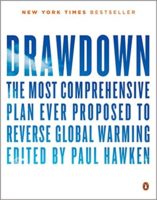
Drawdown was a major collaborative effort involving 70 research fellows from 40 countries. It’s not so much a cohesive plan as a list of partial solutions: 80 that are tested and in use at least somewhere in the world, and another 20 that are speculative. The book has a few essays but is primarily composed of descriptions of these possible solutions; each comes with estimates of its potential impact on climate, and a ranking (and a picture, naturally).
These numbers are speculative, of course. One of the things I found surprising was the estimates in a few cases of the potential of solutions—in particular, a back-to-back pair: using bicycles instead of motor vehicles in cities was estimated to increase from 5.5 percent of trips in 2014 to 7.5 percent by 2050. But green roofs and cool roofs (that is, roofs with turf on top and roofs with reflective metal that sends solar radiation back) are estimated to grow to 30 and 60 percent, respectively. That totals to 90 percent as the two are different approaches with no overlap. I can only think that people doing the bike chapter were much less optimistic than those coming up with numbers for the green roof piece.
The other issue with numbers is the question of double counting, of overlap. For example, it seemed to me that farmland restoration, regenerative agriculture, multistrata agroforestry, silvopasture, tree intercropping, managed grazing, pasture cropping, and intensive silvopasture are not really eight different schemes, but three. A problem with any assessment of climate change is assigning categories and avoiding overlap. For example, take a truck bringing corn to an ethanol plant—is that in the transportation sector, the agriculture sector, or the energy production sector? But the authors claim they “made sure to avoid” double counting; perhaps I misunderstood the differences between some of these things. Anyway, I don’t think the numbers are the important part of this effort.
…click on the above link to read the rest of the article…
